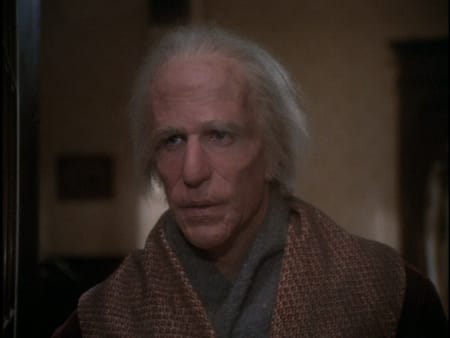Rote adaptations of Charles Dickens' 1843 novella A Christmas Carol are a dime a dozen, with a vast amount of filmmakers having produced versions that retain the 19th Century London setting as well as all the proverbial characters. It has been done to death so much that straight retellings are now completely superfluous. Announcing itself to be different via its title, 1979's An American Christmas Carol transplants the classic story to Depression-era America in the 1930s, retaining Dickens' core story elements and thematic principles while putting a new name and face on the old tale.

Standing in for Ebenezer Scrooge is curmudgeonly businessman Benedict Slade (Winkler). Set in New Hampshire in 1933, Slade spends his Christmas Eve driving around town with his assistant, Mr. Thatcher (Thomson), out to heartlessly repossess goods and properties from the less fortunate. Thatcher is fired after questioning Slade's bitter behaviour, forcing him to return to his family with bad news and a bleak outlook for his sickly young son Jonathan (Cragg). Alone on the night before Christmas, Slade is visited by the spirit of deceased business partner Jack Latham (Pogue) who warns Slade about what the afterlife may hold for him. Throughout the night, Slade is then visited by several more apparitions who guide him through his past, present and potential future, hoping to make him see the error of his ways and perhaps persuade him to fix his life before he meets with a lonely death.
Wisely, writer Jerome Coopersmith did not simply copy and paste the highlights of A Christmas Carol into the 1930s setting. An American Christmas Carol disposes of the ancient Dickens dialogue, and, though the story is essentially the same, not every scene or character is given an equivalent here. In fact, some of the most memorable moments and passages were done away with; Slade doesn't even use the phrase "humbug" at any point. Coopersmith also worked to make certain aspects of the story relevant in its new setting. For instance, instead of growling at people seeking donations for the orphanage, Slade warmly invites them into his business and gifts them with leaflets containing advice about self-reliance and financial responsibility. In spite of the changes, the movie still upholds the spirit of Dickens' story to the letter, effectively reinforcing the relevant messages of the source material.

Director Eric Till (A Muppet Family Christmas) has a talent for storytelling, as An American Christmas Carol is well-paced and at times absorbing. The flick's greatest success is its trip into Slade's past. This particular section of the narrative is meaty and engaging, with the script borrowing elements of Ebenezer Scrooge's recognisable past but ultimately providing a fresh-feeling background for Slade that's relevant to both the period and the setting. However, An American Christmas Carol is a made-for-television movie, and this is often obvious. Although production values are usually impressive and the flick was lensed in 35mm film, the cinematography lacks flair, giving the film a flat and basic appearance. Added to this, there is not a single attempt to make the ghosts look like anything other than regular people, hence this adaptation is at no point frightening or dark enough. Plus, the Ghost of Christmas Yet to Come is an African American in '70s fashion, which seems somewhat corny and makes the picture look dated.
An American Christmas Carol was produced in 1979, at the height of Fonzie-mania. Henry Winkler was renowned and recognised for played Fonzie in Happy Days, hence the actor wanted to feature in more projects that would help him live down the Fonzie image and show he that was more than just a leather jacket and a catchphrase. In the role of wealthy Scrooge-esque businessman Benedict Slade, Winkler is a mixed bag. He fares best in the scenes of Slade's past since he looks more at ease with the role and his face isn't obscured by make-up. As elderly Slade, however, Winkler is not quite convincing. The make-up is strictly okay, and Winkler has trouble effectively selling himself as an old man. His mannerisms are half-baked, while his voice sounds forced and youthful. At times the illusion works, but for the most part Winkler's performance is underwhelming.

An American Christmas Carol probably seems pointless, especially since a number of excellent A Christmas Carol adaptations are readily available. Nevertheless, this American retelling is worth a watch. Even though the film's final resolution is completely predictable and the story's messages have grown trite, this production tells the story well, and it's interesting to see how the filmmakers handled the change from England to America.
6.8/10
 Login
Login Posted : 11 years, 3 months ago on 3 January 2013 11:59
Posted : 11 years, 3 months ago on 3 January 2013 11:59
 0 comments,
0 comments,